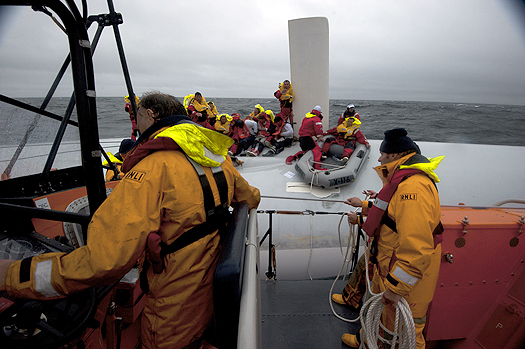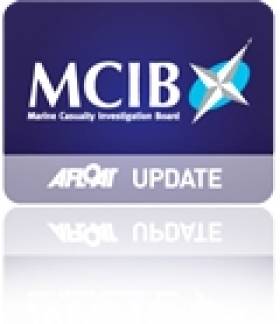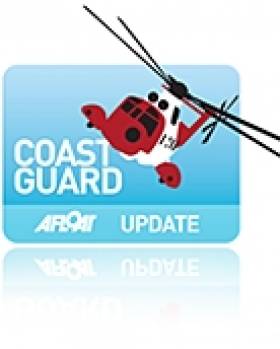Displaying items by tag: Rambler 100
Rambler We Hardly Know You....
Last time the Irish maritime community were paying full attention to the super-maxi Rambler 100, she was white all over, she'd no keel, and she was upside down after her capsize near the Fastnet Rock during the race of 2011 writes WM Nixon.
Now she's sailing again in full racing trim. But Rambler, we hardly know you. You're right way up. Your canting keel is presumably very securely in place. And you're black, black, BLACK.
The new campaigner who has undertaken the massive refurbishment – if that's the right word – is Australian owner-skipper Anthony Bell. The restoration was done in New Zealand, where the big Juan K-designed machine was built by Cookson's in the first place, but everything about the boat's current career will be Australian-centred.
Her official launch earlier this month was performed by the Oz Prime Minister Tony Abbott, and the boat is now Perpetual LOYAL in a sponsorship linkup between two leading Australian brands. And of course the Sydney-Hobart Race on December 26th will be the debut par excellence, for despite being around for quite a few years now, even while being constantly up-dated the big lady has never done the dash to Tasmania.
So naturally the battle for line honours between current record-holder, the 100ft Wild Oat XI (owned by 35th America's Cup Challenger of Record Bob Oatley) and Perpetual Loyal is going to grab the headlines. But Wild Oats' current up-grade programme suffered a recent serious setback with the "catastrophic failure" of a new large lighter mast.
However, for Perpetual LOYAL aka Rambler Re-born, it's all systems go. Although Anthony Bell is himself has a CV of three Hobart races, he has signed on 29-races veteran Michael Coxon as sailing master, legendary American techno-ace Stan Honey is navigator, and the afterguard includes Olympic Gold Medallist and America's Cup superstar Tom Slingsby.
With entries looking to surge comfortably over the hundred mark, it has all the makings of a vintage Sydeny-Hobart, as there'll be a particularly good turnout among the biggies. Further down the fleet, Irish interest will also focus on the boats of the Round-the-World Clipper Fleet, taking part in the Hobart race for the first time. This a good move as it makes the Knox-Johnston project much more part of mainstream sailing, and the man himself will be navigating a former clipper boat in the race too.
But each Hobart race proves to be very much a case of horses for course, and over the years former CYCA Commodore Matt Allen (a veteran of 23 races) has concluded that a potent 60 footer offers the best all-round chance for the Tattersall's Cup, the prized troiphy for the overall handicap win. His new Carkeek 60 Ichi Ban is barely out of the wrappers after arriving from the Matt Allen-owned building facility in Dubai. With the looks of an up-dated and enlarged TP52, and current Australian champion offshore skipper Gordon Maguire on the helm, Ichi Ban might well be worth a flutter over Christmas.
Tug that Righted “Rambler 100” Barges Ahead
#TOWAGE – The tug Ocean Bank that righted the capsized US entrant Rambler 100 following the Rolex Fastnet Race 2011, arrived in Dublin Bay recently with a barge under tow, writes Jehan Ashmore.
The Rambler 100 had overturned in force-five winds off Fastnet Rock arising from "dramatic and catastrophic" failure of the keel triggered events that ultimately delayed the rescue of the majority of her 21-strong crew, according to the official report by the MCIB into the capsize.
After the rescue of Rambler 100's crew, the yacht remained adrift but eventually was recovered by the Bere Island based tug Ocean Bank to the shelter of Barley Cove, west Cork. From there the 30 tonne bollard pull tractor tug operated by Atlantic Towage & Marine successfully up-righted the yacht.
This week's operation by the Ocean Bank involved towing a completely different type of vessel, the construction barge Skerchi from the south-west coast to a berth alongside Ocean Pier in Dublin Port.
MCIB Report on Fastnet Yacht Rambler 100 Highlights Issues that Delayed Crew's Rescue
#RAMBLER 100 - The "dramatic and catastrophic" failure of the keel on the Fastnet Race yacht Rambler 100 triggered a series of events that ultimately delayed the rescue of the crew, according to the official report into the capsize.
Among the conclusions of the report by the Marine Casualty Investigation Board (MCIB) were that the upturned vessel would have been visible from a much greater distance by rescue crews had the hull been painted with a bright colour.
The report also advised yachtsmen to look out for signs of keel failure on one-off design yachts, many of which in previous cases were found to be caused by weld fractures.
As previously reported on Afloat.ie, the Rambler 100 capsized shortly after rounding Fastnet Rock during the 2011 edition of the Fastnet Race on 15 August last year.
Sixteen of the 21-strong crew managed to climb onto the upturned hull, while the other five were later picked up from the water after drifting away from the vessel. Photos of the rescue of the yacht's crew are available HERE.
The MCIB report found that the 100-foot racing yacht capsized very quickly once the keel had fractured, surprising the crew and leaving them no time to react other than to get to safety.
Because of this, a number of opportunities that may have hastened their rescue were missed, the report outlines.
Firstly, a 'Mayday' broadcast via the yacht's installed VHF received no response, possibly because the mast was quickly underwater. The navigator's handheld VHF radio was also lost while he was swimming out of the capsizing vessel.
It was noted that two grab bags containing EPIRBs were stored under the navigator's seats port and starboard which proved inaccessible once the boat was capsizing. The report concludes that had such equipment been located within reach of the companion way or by the helm, it would have proved easier for one of the crew to grab before leaving.
Two liferafts stored in containers on the aft deck were also inaccessible with the hull inverted. An alternate method of releasing them from their storage box would have made it possible to launch at least one of the rafts, the report asserted.
It was found that the leverage of the water ballast tanks contributed to the rapid inversion of the vessel once the boat lay on her side in the water. This left no time for the off-watch crew below deck at the time of the incident to reach either foul weather gear or personal flotation devices (PFDs).
The report also recommended that an escape hatch would have aided the off-watch crew's escape from the upturned hull, though thankfully they were able to remove themselves from below deck without becoming tangled in loose ropes or other equipment.
Although each crew member was issued with a safety pack containing a PLB and strobe light, only two were available to those on the upturned hull, and none to the five who drifted away. The report states that it "would have greatly aided the rescue services had each of the survivors carried their own PLB and activated it on entering the water".
Moreover, it was found that incomplete registration information for the two PLBs that were activated caused some confusion as to the identity of the vessel in distress, and led to a delay of around an hour before a full-scale search ad rescue operation was launched.
The report did not investigate the reason for the keel failure, only the fact that it caused the capsize, and that further analysis on the keel is being carried out by the appropriate authorities.
The MCIB also outlines a list of safety recommendations based on its conclusions which have been made primarily to the International Sailing Federation (ISAF) for inclusion in its special regulations for future offshore racing events.
The full report is available to download via the link below.
Fatality Rate for Fishermen An 'Absolute Tragedy'
Fishermen and farmers make up more than half of all work-related fatalities in Ireland, according to the Minister for the Marine.
As The Irish Times reports, Simon Coveney TD decried it as an "absolute tragedy" in the Dáil.
He noted the progress being made in encouraging people to wear safety gear when on the water, but said there was "little or no progress in getting fishermen to wear lifejackets”.
"For some reason fishermen seem to think they will never fall in the water," the minister commented.
Cork South West TD Noel Harrington also raised the point of the Department of the Marine's refusal to use personal beacons that directly signal emergency services, rather than emergency position indicating radio beacons (EPIRB).
He referred to the capsizing of the Rambler 100 yacht in the Fastnet Race in August, saying that the latter did not go off to alert the coastguard as the boat had not sunk.
Software Instrumental to Rescue of Rambler 100 Crew
Search and rescue mapping software developed in Rhode Island was "instrumental" in efforts to retrieve crewmembers from the stricken Rambler 100 off Fastnet last week.
The SARMAP software, developed by ASA (Applied Science Associates, Inc) provides rapid predictions of the movement of drifting objects and missing persons at sea.
For search and rescue units it can provide search patterns and calculate the probability of containment, probability of detection, and probability of success.
As previously reported on Afloat.ie, the Rambler 100 capsized off the Cork coast while competing in last weekend's Rolex Fastnet Race.
The Rambler 100’s personal locator beacon activated when the yacht overturned, which alerted rescuers to the location of the 16 stranded crewmembers still with the vessel, but recovering the five lost at sea required a more advanced approach.
The Irish Coast Guard used SARMAP’s sophisticated tracking capabilities to predict the movement of the drifting survivors and calculate a precise search area.
ASA president Eoin Howlett commented: “We have successfully worked with the Irish Coast Guard for many years; they are an innovative agency and have a history of implementing the latest in ocean technologies.
"We are very pleased that our software, combined with their rapid decision-making, resulted in such a positive outcome.”
Injured Fisherman Airlifted to Hospital by Shannon Coastguard
An injured man fisherman airlifted to hospital yesterday from a boat off Kerry coast, The Irish Times reports.
The Shannon-based Irish Coast Guard helicopter was dispatched to assist the crewmember on the UK-registered fishing vessel Achieve, some 110 miles southwest of the Blasket Islands.
He was airlifted to Tralee Regional Hospital, where he is being treated for serious injuries.
The incident marked the fourth time that the Shannon helicopter has been called into action this week.
This included its assistance of the crew of the yacht Rambler 100, which capsized near Fastnet Rock while competing in this year's Rolex Fastnet Race last weekend.
Ferry Runs Aground off Doolin for Three Hours
According to ferry operator Kevin O'Brien, there were no passengers on board at the time and the vessel got under way again when it was lifted from the rocks with the tide. Mr O'Brien added "this was a very minor incident and there was no damage to the ferry. Doolin is tidal so these things do happen. Even a few inches of water can make a difference".
The Irish Coast Guard was notified of the incident at midday, and its marine rescue co-ordination centre in Dublin requested that members of the local Coast Guard unit board the vessel to assess if there was a pollution risk.
Doolin Coast Guard personnel carried out an inspection and confirmed the ferry had not been damaged and there was no risk of pollution. At about 2.15pm the ferry got under way again with the tide. The company was able to operate services to and from the Aran Islands with its second vessel.
Rambler 100 Crew Member 'Feels Lucky to be Alive'
An Australian crewmember on the stricken Rambler 100, which capsized in high winds during yesterday's Rolex Fastnet Race, has told reported that he feels "lucky to be alive".
Mike Motti was one of five crew who were separated from the yacht when it overturned near Fastnet Rock off the Cork coast.
He and his fellow crewmembers spent two hours adrift on a liferaft before they were rescued in foggy conditions which made the search all the more difficult.
“I’m feeling lucky to be alive, happy to be here and it’s great to see the local people here to greet us,” Motti told The Irish Times.
Fellow crewman Michael van Beuren said the yacht capsized within 30 seconds when its keel fin snapped in heavy seas.
All 21 crew were rescued from the yacht last night in an operation led by the Baltimore RNLI lifeboat and the Irish Coast Guard.
Phaedo Team's Dramatic Rescue Photos of Rambler 100 Crew
Antoher competing yacht in the Fastnet race captured dramatic photos of the stricken 100-footer. Team Phaedos' media personnel who were at the Fastnet Rock last night waiting for photogrpahs of their big catamaran passing 'the Rock' when they got a call from the Irish Coastguard for all ships in the area to be on standby.
The media crew immediately abandoned the photography project and called in to the Coasguard to offer help. They found all crew on the up-turned hull of Rambler were fine and well, but 5 crew had drifted off from the upturned hull and were no longer in sight. They searched the area were they had received a personal EBIRB transmission from and miraculously found the missing 5 crew after they had been in the water for 3 hours.
"We pulled aboard our dive vessel owner George David and his four crew members who had all been strapped together, cold, but healthy, happy, safe, and well" said Team Phaedo's Rachel Jasperson. Dramatic Photos below.


r
Baltimore RNLI lifeboat crew were involved in the major rescue operation this evening (Monday 15 August 2011) when a 100 ft yacht capsized during the famous Fastnet race with a crew of 21 onboard. Five of the crew were missing when the lifeboat arrived on scene while the remaining sixteen were huddled together on the upturned hull.

Baltimore lifeboat finds crew clinging to a daggerboard. Photo: RNLI
The Baltimore RNLI lifeboat was out on exercise near the Fastnet rock when they were alerted by Valentia Coast Guard that an emergency signal had been picked up. The lifeboat volunteer crew under Coxswain Keiron Cotter proceeded to the area and started a search. About sixteen miles southwest of Baltimore and five miles south of the Fastnet the lifeboat crew spotted the upturned yacht with the sixteen crewmembers on the hull. They told the lifeboat volunteers that five of their crew had drifted away from the yacht. After a short search the Coxswain returned to the scene and recovered the casualties onboard. They had been there for approximately three hours since their yacht capsized shortly after 5.30pm.
The other five crewmembers who were missing had managed to tether themselves together and were spotted in the water by the Baltimore deputy mechanic Jerry Smith who had taken out his own Dive boat to join in the search. One of the five was airlifted by the Irish Coast Guard helicopter to receive medical attention.

Rescued crew rejoice that all are safe, some spent three hours in the water. Photo: RNLI
The remaining twenty were brought ashore at Balimore Harbour and taken to the local sailing club to be assessed.
Baltimore RNLI Coxswain Keiron Cotter said, "We had no idea what we were looking for and it was extremely hard to spot the upturned yacht in the water. They had been there for about three hours with other vessels in the race passing nearby but not being able to see them. We were out on exercise in the area where they capsized and we must have just missed them by minutes.
We saw a light in the distance and did not know what it was so we went closer to investigate it. When we got nearer we saw that it was a torch the casualties were flashing to attract attention. Our priority was to get them back to shore as quickly as possible."
More photos and latest news in our Fastnet Coverage here






































































